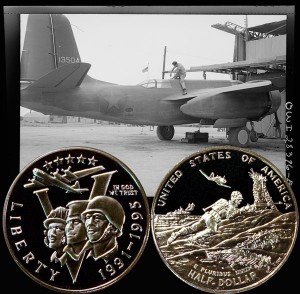Today, the World War II Commemorative Half Dollar Coin remembers D-Day with an article printed on June 6, 1944 about America’s rapid war plane production.
From The Telegraph [Nashua, NH]:
=====
Invasion Force Being Readied For Two Years
James J. Strebig, Associate Press Aviation Editor
America built in about two years the winged fury which has now been flung into support of the Allied invasion.
The speed in assembling such a vast force rivals in awesomeness the aerial might itself, an air force the like of which had not been dreamed before Munich or since, except in the United States.
Hitler smashed into Poland with about 1,500 planes, executed the Norway campaign with fewer than 1,000 and pushed through the lowlands with something over 3,000.
When it came Hitler’s turn to defend, those figures were dwarfed by the Allied armada, a flying fighting force which counted planes by the tens of thousands, planes which could fly faster and hit harder than anything the Nazis ever built, planes which came from 40,000 factories and many millions of workers.
The United States entered the war, as General H. H. Arnold, commander of the Army Air Forces, said, “with plans but no planes.”
Of the 3,000 Army airplanes available on December 6, 1941, only 1,157 were suited to combat service. Actually, none of them could stay in the air against 1944 models.
In a matter of hours on December 7, 1941, the Japanese reduced our combat-suited aircraft total to 800 and for some time thereafter whittled it down still further before American production began to swing up.
The Army’s only fighter then in mass production was the P-40 Warhawk, a sturdy plane lacking in performance but which then carried and in improved models, still carries a sizeable responsibility.
Bombing was done principally by the C and D models of the B-17 Flying Fortress, the B-25 Mitchell and the A-20 Havoc. Also in service in small numbers were the B-24 Liberator, the B-26 Marauder and the A-24 Dauntless.
The B-17 had first been flown six years earlier, at about the time work was started on the B-24. Being readied for action at the time of Pearl Harbor were the P-38 Lightning, an extremely versatile, high performance fighter; the P-39 Airacobra, which yielded two years later to a much improved version; the P-47 Thunderbolt, high flying slugger which did not get into the air until after the war began and the P-51 Mustang, rated by many the world’s best single-engined fighter.
Literally dozens of other warcraft were on drafting boards, but few of them have passed the army’s rigid requirements.
Variety in aircraft was sacrificed to production.
About 19,000 airplanes were build in 1941. The 1943 total was 85,946, and the weight of each plane was nearly double that of the pre-war model.
The early 1944 rate of production was around 110,000 a year with a still greater average weight.
The Army’s plans called for pilots and other crewmen to fly those airplanes. Only 696 pilots were graduated in 1941; the total for 1943 was 65,000.
In 1941, the Army turned out 601 navigators and 310 bombardiers, but no aerial gunners or ground technicians.
The Air Forces training command graduated 13,783 navigators, 13,998 bombardiers, 81,398 aerial gunners, 513,333 technicians and 18,850 others in various classifications in 1943.
Those figures are a simple story of how Americans built for war while fighting one.
During those two years, newly produced planes and air crews were rushed to battle in the Pacific, in Africa and Europe.
=====
On D-Day, newspapers reported 11,000 airplanes supported the Allied invasion.
The World War II Commemorative Half Dollar Coin shows with an image of an American mechanic readying a newly build airplane for delivery to Russia forces.
